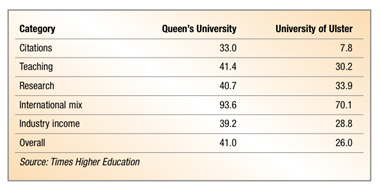 The pros and cons of ranking campuses.
The pros and cons of ranking campuses.
Each year, the Times Higher Education magazine (THE) ranks the most successful 200 universities, which are considered as representing roughly the top 1 per cent in the world. A high place gives prestige but the full picture is told in the statistics used to calculate a ranking. However, some academics dismiss the idea that universities can be accurately compared in this way.
Published in mid-September, this year’s World University Rankings gave the top 10 places to British and American institutions. Harvard came first on a score of 96.1. Cambridge and Oxford were joint sixth (91.2) with Imperial College London placed ninth (90.6).
Trinity College Dublin was the Republic’s top institution, coming fourteenth in Europe (60.3), followed by University College Dublin at twenty-sixth (57.5). Queen’s stands at 41.0 (256th) and the University of Ulster at 26.0 (392nd).
Rankings below the 200 mark tend to be less accurate in separating universities according to their performance but they do show how close an institution is to reaching the top category.
Times Higher Education says that this year’s rankings should be considered “the first of a new annual series” as the methodology has been overhauled.
Thirteen separate performance indicators are used, to cover the full range of university activities, from teaching to research and knowledge transfer. These are then grouped under five headings, which contribute the following shares to the final score:
• Citations (32.5 per cent);
• Teaching (30 per cent);
• Research (30 per cent);
• International mix (5 per cent); and
• Industry income (2.5 per cent).
Results on the universities’ teaching and research reputations, from the Thomson Reuters Academic Reputation Survey, contributed to 34.5 per cent of the whole score. The survey, carried out this spring, received 13,388 responses from academics worldwide. ‘Citations’ measures the average citations per paper, while ‘international mix’ covers international to domestic ratios among staff and students.
The table below shows how both local universities perform in each category; the maximum score in all cases is 100.
Both do well on international mix, which is a particular strength in the UK. The major difference is in the citation index, perhaps explained by Queen’s having higher profile academics.
This whole concept has, though, been questioned by University College London’s Provost, Malcolm Grant. He questioned whether a newspaper would draw up a table comparing the world’s cities.
Universities “shoot up or down their league tables” each year but he believes that these “fall miles short of capturing anything like the variety, the dynamism and the diversity of the modern university.” Some indicators, such as income per academic, are “curious proxies”.
UCL, for the record, is twenty-second in the world.
Phil Baty, who edits the World University Rankings, acknowledged that rankings systems are “imperfect” as they aim to simplify complex institutions into a numerical data set “but nevertheless we know that hundreds of thousands of people in the global academe find our rankings useful and informative.”
Analysts can study and filter the data, according to their personal preferences, either online or by using the rankings’ iPhone application, which includes the top 400.






